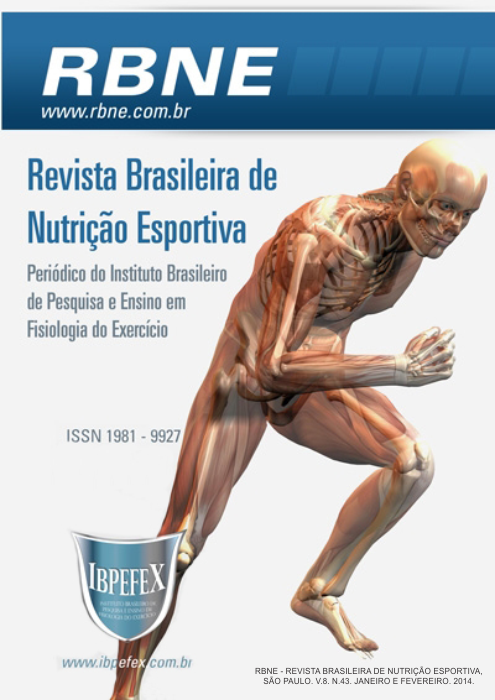Acute treatment whit caffeine and L-Arginine reduces glucose levels in obese rats submitted to aerobic exercise
Abstract
Introduction: Obesity is a major risk factor for metabolic syndrome. This syndrome comprises a group of conditions including insulin resistance, diabetestype two and hypertension. Obese individuals may develop in parallel insulin resistance with obesity, while it remains normal glucose tolerance, the pancreatic beta cells to increase production and secretion of insulin as a compensatory mechanism. Studies have shown positive effects of caffeine and L-arginine on the reduction in glucose tolerance and increased insulin sensitivity. Methods: We used 10 adult male Wistar rats, 4-month-old boy with obesity induced by monosodium glutamate (MSG). We conducteda swim test lasting 30 minutes and measured blood glucose levels before and after exercise and supplementation. Results: The animals that received caffeine reduced (14%), for L-Arg was reduced to L-Arg was reduced (10%) or placebo (65%). Conclusion: The results showed that acute caffeine intake could be modifying the availability or glucose metabolism in obese mice along with exercise, however these data should be supplemented in the new study howevertry to follow the results of studies in the literature.
References
-Balon, T.W.; Nadler, J.L. Nitric oxide release is present from incubated skeletal muscle preparations. J. Appl. Physiol. Vol. 77. Núm. 6. p. 2519-2521. 1994.
-Bruton, J.D.; Lemmens, R.; Shi, C.L. Ryanodine receptors of pancreatic beta-cells mediate a distinct context-dependent signal for insulin secretion. FASEB J. Vol. 17. Núm. 2. p. 301-303. 2003.
-Cahova, M.; Vavrinkova, H.; Kazdova, L. Glucose-fatty acid interaction in skeletal muscle and adipose tissue in insulin resistance. Physiol Res. Vol. 56. Núm. 1. p. 1-15. 2007.
-Coll, T.; Rodrıguez-Calvo, R.; Barroso, E. “Peroxisome proliferator-activated receptor (PPAR) β/δ: a new potential therapeutic target for the treatment of metabolic syndrome,” CurrentMolecular Pharmacology. Vol. 2. Núm. 1. p. 46-55. 2009.
-Conde, S.V.; Nunes da Silva, T.; Gonzalez, C.; Mota Carmo, M.; Monteiro, E.C.; Guarino, M.P. Chronic caffeine intake decreases circulating catecholamines and prevents diet-induced insulin resistance and hypertension in rats. British Journal of Nutrition. Vol. 107. Núm. 1. p. 86-95. 2012.
-Chu, Y.F.; Chen, Y.; Black, R.M.; Brown, P.H.; Lyle, B.J.; Liu, R.H.; Ou, B. Type 2 diabetes-related bioactivitiesof coffee: Assessmentof antioxidant activity, NF-κB inhibition, and stimulationof glucose uptake. Food Chem. Vol. 124. Núm. 3. p. 914-920. 2011.
-Defronzo, R. A.; Abdul-Ghani, M. A. Preservationofβ-cell function: thekeyto diabetes prevention.Journal Clinical Endocrinology Metabology. Vol. 96. Núm. 8. p. 2354-2366. 2011.
-Egawa, T.; Hamada, T.; Kameda, N.; Karaike, K.; Ma, X.; Masuda, S.; Iwanaka, N.; Hayashi, T. Caffeine acutely activates 5′adenosine monophosphate–activated protein kinase and increases insulin-independent glucose transport in ratskeletal muscles. Metabolism Clinical and Experimental. Vol. 58. Núm. 1. p. 609-1617. 2009.
-Lee, S.; Hudson, R.; Kilpatrick, K.; Graham, T.E.; Ross, R. Caffeine ingestionis associatedwith reductionsin glucose uptake independentof obesityand type 2 diabetes beforeand after exercise training. Diabetes Care. Vol. 28. Núm. 3. p. 566-72. 2005.
-Michishita, R.; Shono, N.; Kasahara, T.; Tsuruta, T. Effects of low intensity exercise therapy on early phase insulin secretion in overweight subjects with impaired glucose tolerance and type 2 diabetes mellitus. Diabetes Res Clin Pract. Vol. 82. Núm. 3. p. 291-297. 2008.
-Moustafa, A.; Sakamoto, K.Q.; Habara, Y. A fundamental role for NO-PLC signaling pathway in mediating intracellular Ca2+ oscillation inpancreatic acini. Nitric Oxide. Vol. 24. Núm. 3. p. 139-150. 2011.
-Park, S.; Scheffler, T.L.; Gunawan, A.M.; Shi, H.; Zeng, C.; Hannon, K.M.; Grant, A.L.; Gerrard, D.E. Chronic elevated calcium blocks AMPK-induced GLUT-4 expression in skeletal muscle. Am J Physiol Cell Physiol. Vol. 296. Num.1. p. 106-115. 2009.
-Park, S.; Jang, J.S.; Hong, S.M. Long-term consumption of caffeine improves glucose homeostasis by enhancing insulinotropic action through islet insulin/insulin-like growth factor 1 signaling in diabetic rats. Metab Clin Exp. Vol. 56. Núm. 5. p. 599-607. 2007.
-Plockinger, U.; Topuz,M.; Riese, B.; Reuter, T. Risk of exercise-induced hypoglycaemia in patients with type 2 diabetes on intensive insulin therapy: Comparison of insulin glargine with NPH insulin as basal insulin supplement. Diabetes Research and Clinical Practice. Vol. 81. Núm. 3. p. 290-295. 2008.
-Weyer, C.; Bogardus, C.; Mott, D.M.; Pratley, R.E. The natural history of insulin secretory dysfunction and insulin resistance in the pathogenesis of type 2 diabetes mellitus. J Clin Invest. Vol.104. Núm. 6. p. 787-794. 1999.
-Young, M.E.; Leighton, B. Evidence for altered sensitivity of the nitric oxide/cGMP signalling cascade in insulin-resistant skeletal muscle. Biochem. J. Vol. 329. Núm.1. p. 73-79. 1998.
-Yasuda, N.; Inoue, T.; Horizoe, T.; Nagata, K.; Minami, H.; Kawata, T.; Hoshino, Y.; Harada, H.; Yoshikawa, S.; Asano, O.; Nagaoka, J.; Murakami, M.; Abe, S.; Kobayashi, S.; Tanaka, I. Functional characterization of the adenosine receptor contributing to glycogenolysis and gluconeogenesis in rat hepatocytes. EurJ Pharmacol. Vol. 17. Núm. 2-3. p. 159-166. 2003.
Authors who publish in this journal agree to the following terms:
- Authors retain the copyright and grant the journal the right of first publication, with work simultaneously licensed under the Creative Commons Attribution License BY-NC which allows the sharing of the work with acknowledgment of the authorship of the work and initial publication in this journal.
- Authors are authorized to enter into additional contracts separately for non-exclusive distribution of the version of the work published in this journal (eg, publishing in institutional repository or book chapter), with acknowledgment of authorship and initial publication in this journal.
- Authors are allowed and encouraged to post and distribute their work online (eg, in institutional repositories or on their personal page) at any point before or during the editorial process, as this can bring about productive change as well as increase impact and impact. citation of published work (See The Effect of Free Access).






